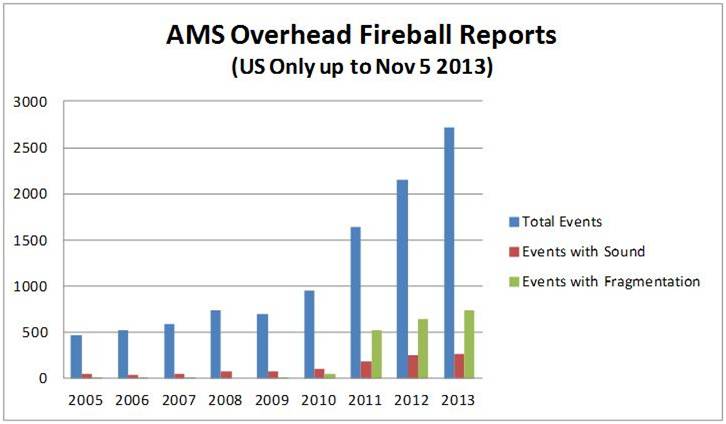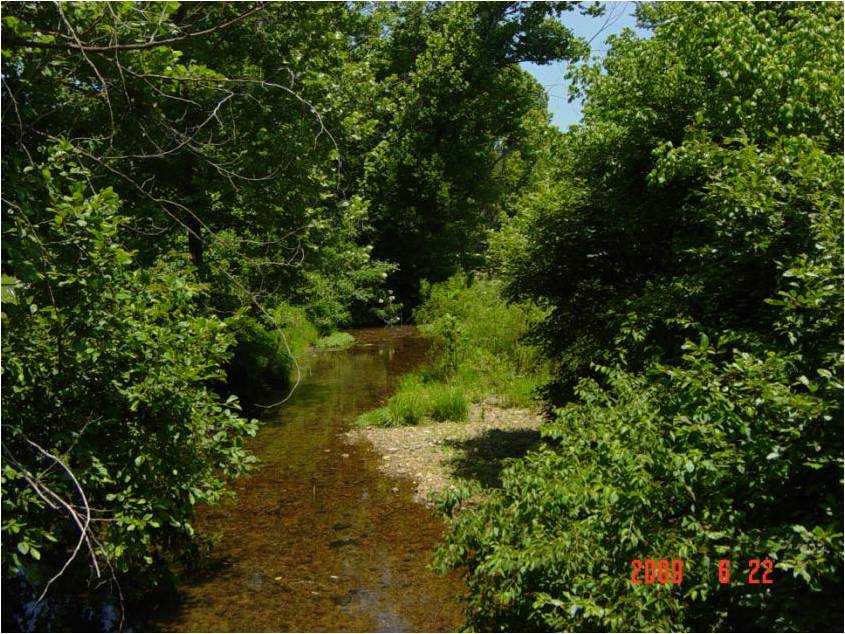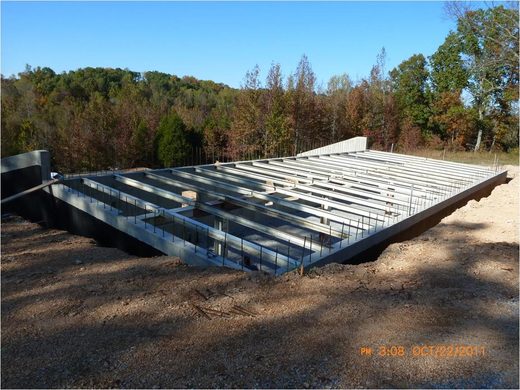Our current collective condition has never been more precarious - at least not in our lifetime. Worldwide economic collapse seems certain, only the timing and severity can be debated. The planet seems to be convulsing through all kinds of changes, from weather extremes to increased earthquake/volcanic activity, to mass animal die-offs, to greatly increased bolide/fireball events.

© sott.netRecent US fireball reports (including sound and fragmentation)
Some of these changes are reflected in changes we can see occurring on other planets in our solar system, and may be related to the bizarre behavior of our sun and/or the nature of space around our solar system. Respected meteorologists and atmospheric scientists are warning of an
impending ice age - the beginning of which
could occur rapidly and with little warning. Secondary concerns have been widely expressed regarding worldwide food supply, not to mention rising prices and environmental instability.
The point here is not to stimulate panic.
The point is to focus on what we can do as individuals and groups to prepare a living environment that is mindful of potential threats - an environment we can create with the means at our disposal. Just thinking and planning around this is preparation itself.
If (more like when) a disaster strikes and our response has been prepared, the psychological value is priceless. You can be reasonably assured that you will not need immediate help and be available to help others who not so well prepared.

© Tele Atlas
Interest in modest rural land tracts has increased significantly over the last few years. For many, this interest involves a retreat from urban environments that are likely to suffer most from economic or environmental disasters.
Internet-based employment, scaled-back lifestyle, reduced consumerism, and early retirement are fueling the motivations to acquire land and skills to support a prepared response to whatever comes our way. I think many of these folks look forward to a more meaningful lifestyle and experience a growing desire to help support the local community in which they land.
So, in this article I want to address the important criteria for location and land tract selection for the best chance of success - both financially and operationally. The sections below are treated roughly in order of importance with respect to the spectrum of possible threats.
General location
© Unknown
Take a look at world maps that show the lowest latitude extents of the ice sheets during the last ice age. You will probably want to consider areas that are at least 100 miles away from the lowest latitude incursions. There is good evidence that the land-based climate away from the ice sheets was not much different than that of today, and that summers were
cooler and more tolerable further south from the ice sheets.
It is probably desirable to stay at least an equal distance (100 miles) from coastal areas due to uncertainty in weather/climate patterns and possible tsunamis. One hundred miles may seem like a lot, but coastal devastation will likely result in mass migrations of refugees from these areas, and you will want a good buffer zone. In fact, 100 miles may not be enough.
Another important consideration for the general location is fresh water. Areas with 40-60 inches (100-150 cm) per year rainfall rate will generally have plenty of ground water at shallow depth for a well. Such areas will likely be lush with vegetation and appropriate for raising animal stock without heavy reliance on supplemental feeds. Natural creeks and springs may offer additional benefits. Birds, bees, and abundant wildlife are very good signs - particularly if hunting becomes necessary.
When you begin to narrow down the possibilities to more specific areas, take a look at the County level. Look for Counties (or provinces) that do not contain any large metropolitan areas. If the County is primarily rural then it will likely be friendly for wells, building, farm infrastructure, low-cost labor, etc. "Rich" counties are much more associated with deep levels of bureaucracy that can put a real strain on your time and budget.
Land tract characteristicsHow much land do you need? Let's say you would like to support a breeding pair of cows and a family of pastured hogs (chickens are not a driver). You will want enough pasture (and good grass) to support the cattle and enough pasture-bordered forest to support movable paddocks for the pigs. For this minimal operation you probably need about 15-20 acres (6-8 hectare) depending on the productivity/quality of the land. Keep in mind that you will probably wish you had more, and you
will need more if you plan to provide plenty of animal products for sale in business.
How much of the land should be in pasture? A general rule of thumb you might use is 60% pasture, 40% woods - but this will depend on your planned usage. The wooded part of the property will come in handy if you plan to heat with wood.
If the initial land cost is too much for your budget (or you want to expand later), then you can look into leasing adjacent or nearby land for your animal operations. Lease rates for this kind of land use are generally very low. Remember, by putting animals on the land, you are improving it. Take a close look at the land (and neighbors) adjacent to the potential land tract choice.
If you have to travel to see a candidate area or tract of land - do it! Nothing beats eyeballs on the land and boots on the ground. And while you're there, check out the area - you may see something you like a lot better. If you see something you really like, contact the owner and make an offer. I've been surprised just how easy it is to buy a piece of someone else's land.
It is generally desirable to have some elevation change across the candidate land tract. A well located near the highest elevation gives one the option of distributing the water downhill by gravity-feed (for animal operations). You will also want to consider the areas of higher relative elevation for living or storage structures. If a well can be located above the house, then it can gravity-feed for domestic use, should the need arise. It is a good idea to use a local dowser to roughly map underground streams for well placement, and to ensure that you do not put a living structure over an underground stream [Note: this has been associated with chronic health problems in the occupants.]
Elevation change across the land tract gives water someplace to go in the event of flooding rains. Land adjacent to a creek that does not rise much in elevation (bottomland) should be avoided due to risk of inundation. Look at the land with an eye to expecting up 20 inches of rain (worst case) in two days. Get topographic maps of the area and evaluate the watershed above the land tract you are considering. From this data you can estimate the water flow rates that local creeks, rivers, or land depressions will have to support. If flooding of a portion of the land tract is possible, then you will need a plan to evacuate any animals to higher ground. Bottomland next to a nice creek may look attractive, but it can easily turn into a temporary lake. You can also ask the locals about the worst flooding they have seen in the area.

A lovely placid creek ...

... turns into this after 13 inches of rain
The two primary infrastructure items for animal operations are water distribution and fencing. A barn is nice but not necessary as long as you have allocated space for dry storage. Perimeter fencing is a plus but is also not necessary since you will likely be using electric fencing to control animal access to the land for mutual maximum benefit to both land and animal. Electric fencing is easily deployed and moved to provide custom paddocks that adjust to land requirements. This allows for the most efficient use and movement of paddocks over the land surface. Many electric fence units are powered by 6V/12V batteries and draw very little current. The batteries are easily recharged with onboard solar panels for continuous use. So, although perimeter fencing is always a good idea, one need not delay deployment of animal operations.
Water distribution, however, is very important to easy animal operations and should be run to all areas that will form future paddocks. Water lines are easily put in place using continuous Pex tubing (below the frost line), and the cost is not a big driver given a good water source.
Group volunteer labor is a great help when it comes to laying in the infrastructure.
Check out
Joel Salatin's Polyface Farms website and read some of his many books to learn how animal operations can improve and heal the land and its soil. He has much to say about how to minimize your own work while maximizing benefits to the land, not to mention producing nutritious food that will enable you to not only survive, but thrive.
Building options
Earth-sheltered home construction showing I-beam supports
There are many good options for erecting a modest living structure, but I would like to suggest looking at earth-bermed and earth-sheltered options from the standpoints of cost, maintenance, strength, and energy efficiency. These options make use of the earth as a heat sink to limit the effects of external temperature excursions, improving comfort and lowering the energy consumed to control the living environment. They must be strong, but, by nature, they blend into the natural landscape. As such, they will stand up to significant environmental insults that would bring down more conventional structures. They are also relatively maintenance-free.
If they are formed with high pressure, steel-reinforced concrete, then the cost is comparable with a conventional wood framed structure. The earth-sheltered version is covered on all sides (including the roof) except the front of the structure. In order to support an earthen roof cover, this version makes use of structural I-beam steel members resting on one foot thick walls. These steel I-beams are available from various scrap dealers awaiting return to the foundry and can be purchased at low cost. Below is a picture of an earth-sheltered home I recently designed and built, as just described, comprising over 2,000 square feet of living space. The roof supports 2.5 feet of earth depth (and is currently growing grass).

Finished earth-sheltered home
The earth-bermed version is similar except it uses a conventional (well-insulated) roof, eliminating the need for the structural I-beam steel. Six inch thick steel-reinforced concrete walls support the conventional roof and added insulation on the exposed wall(s) can be used to improve the thermal efficiency. This version lends itself well to smaller yurt-like structures but retains the earth heat-sink efficiency.
The nice thing about these structures (besides the obvious strength and efficiency) is that the shell can go up very quickly, leaving only the interior finish work for completion. Planning is crucial so that all lines, conduits, etc are accounted for prior to pouring concrete.
If you decide to go with one of these structures, be sure to get your design approved from a structural engineering standpoint by those qualified to do so.
Other considerationsWhen evaluating a land tract, try to find out its past history in agriculture. It's truly hard to find virgin land that has not been mono-cropped or abused in some way through agricultural use. Chemical fertilizers and pesticides go back a long way and have lasting impact on the soil, but recent use of chemicals like glyphosate (Roundup) may be a red-flag warning about a particular land tract. Ask the locals about the history of any land you are considering. Usually, the longer it has been left alone, the better.
If you are thinking of incorporating or upgrading in the future to solar electric power, check for clear sun exposure (in the appropriate direction) from locations near the planned home location. If you intend to use grid power as well, consider installing two house service panel boxes, one for solar and one for the grid. This allows you to move circuits from one power source to the other as needs or reliability change. You can also switch the power source from one box to the other.
You may also want to consider separate drain lines for toilets (sewer/septic) and sinks/showers (gray water). Sink and shower drains can be piped to form a pond downrange from the house. There are many Internet resources that address how to do this properly to enhance the environment.
If animal husbandry is not for you, consider setting up a well-stocked workshop or other service that you can offer the local community in exchange for help, food, etc.
If money is an issue, search out like-minded folk and consider forming a group. The work goes much faster and is so much more enjoyable than trying to do it all yourself.
Nice try.
Pollyanna was a great show.
Hayley Mills was terrific.
Hey? Wanna come out to our farm? I can still show you some of the skulls and remnant skeletons of our precious cows and heifers that died of respiratory failure 2 years ago after Organic Valley, Family of Farms (ceo George Siemon, La Crosse, WI) raped and robbed us and we were left without economic means and without finding anyone to help us. Though I tried and tried and tried, desperately. Talked to many lawyers and many ag experts....
However, I'm sure ol' George and his financial backers will help you find and maintain the farm of your desire, maybe even this one. Certainly they will help you. Of course, of course, of course.
Life and hope and optimism continually spring forth from the soil fertilized by the blood, sweat and tears of the murdered, raped and ravaged. It is quite the rich spectacle!
Plenty of cheap tickets are available as a result.
signed,
murdered, raped and ravaged
or you can call me, ned, nedlud